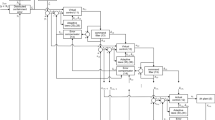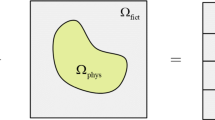Abstract
Simulation coupling (or cosimulation) techniques provide a framework for the analysis of decomposed dynamical systems with the use of independent numerical procedures for decomposed subsystems. These methods are often seen as very promising because they enable the utilization of the existing software for subsystem analysis and usually are easy to parallelize, and run in a distributed environment. For example, in the domain of multibody systems dynamics, a general setup for “Gluing Algorithms” was proposed by Wang et al. It was intended to provide a basis for multilevel distributed simulation environments. The authors presented an example where Newton’s method was used to synchronize the responses of subsystem simulators.
In this paper, we discuss some properties of a simplified iterative coupling scheme, where subsystems’ responses are synchronized at discrete time points. We use a simple multibody model to investigate the influence of synchronization parameters on computations. We also try to provide explanation to the oscillatory behavior of the solutions obtained from this method.
Similar content being viewed by others
References
Anderson, K.S., Duan, S.: Highly parallelizable low order dynamics simulation algorithm for multi-rigid-body systems. J. Guid. Control Dyn. 23(2), 355–364 (2000)
Andrus, J.F.: Numerical solution of systems of ordinary differential equations separated into subsystems. SIAM J. Numer. Anal. 16(4), 605–611 (1979). doi: 10.1137/0716045. URL http://link.aip.org/link/?SNA/16/605/1
Arnold, M.: Multi-rate time integration for large scale multibody system models. In: IUTAM Symposium on Multiscale Problems in Multibody System Contacts, vol. 1, pp. 1–10 (2007)
Bae, D.S., Haug, E.J.: A recursive formulation for constrained mechanical system dynamics: Part I: Open loop systems. Mech. Struct. Mach. 15(3), 383–393 (1987)
Bae, D.S., Haug, E.J.: A recursive formulation for constrained mechanical system dynamics: Part II: Closed loop systems. Mech. Struct. Mach. 15(4), 481–506 (1987)
Bae, D.S., Kuhl, J.G., Haug, E.J.: A recursive formulation for constrained mechanical system dynamics: Part III: Parallel processor implementation. Mech. Struct. Mach. 16(2), 249–269 (1988)
Chawla, B.R., Gummel, H.K., Kozak, P.: MOTIS—an MOS timing simulator. IEEE Trans. Circuits Syst. cas-22(12), 901–910 (1975)
Featherstone, R.: A divide-and-conquer articulated-body algorithm for parallel O(log (n)) calculation of rigid-body dynamics. Part 1: Basic algorithm. Int. J. Robot. Res. 18(9), 867–875 (1999)
Featherstone, R.: A divide-and-conquer articulated-body algorithm for parallel O(log (n)) calculation of rigid-body dynamics. Part 2: Trees, loops, and accuracy. Int. J. Robot. Res. 18(9), 876–892 (1999)
Gear, C.W., Wells, D.R.: Multirate linear multistep methods. BIT 24(4), 484–502 (1984)
Gear, C.W., Gupta, G.K., Leimkuhler, B.: Automatic integration of Euler–Lagrange equations with constraints. J. Comput. Appl. Math. 12, 77–90 (1985)
Gu, B., Asada, H.H.: Co-simulation of algebraically coupled dynamic subsystems. In: Proceedings of the American Control Conference. Arlington, VA (2001)
Gu, B., Asada, H.H.: Co-simulation of algebraically coupled dynamic subsystems without disclosure of proprietary subsystem models. ASME J. Dyn. Syst., Meas. Control 126(1), 1–13 (2004)
Gu, B., Gordon, W., Asada, H.H.: Co-simulation of coupled dynamic subsystems: A differential-algebraic approach using singularly perturbed sliding manifolds. In: Proceedings of the American Control Conference. Chicago, Illinois (2000)
Harchel, G.D., Sangiovanni-Vincentelli, A.L.: A survey of third-generation simulation techniques. In: Proceedings of the IEEE, vol. 69, pp. 1264–1280 (1981)
Hippmann, G., Arnold, M., Schittenhelm, M.: Efficient simulation of bush and roller chain drives. In: Multibody Dynamics 2005, ECCOMAS Thematic Conference. Madrid, Spain (2005)
Kim, S.S.: A subsystem synthesis method for efficient vehicle multibody dynamics. Multibody Syst. Dyn. 7, 189–207 (2002)
Kübler, R., Schiehlen, W.: Modular simulation in multibody system dynamics. Multibody Syst. Syn. 4, 107–127 (2000)
Kübler, R., Schiehlen, W.: Virtual assembly of multibody systems. Stab. Control: Theory Appl. 3(3), 223–233 (2000)
Leimkuhler, B.: Estimating waveform relaxation convergence. SIAM. J. Sci. Comput. 14, 872–889 (1993)
Leimkuhler, B.: Relaxation techniques in multibody dynamics. Trans. Can. Soc. Mech. Eng. 17(4A), 459–471 (1993)
Lelarasmee, E.: The waveform relaxation method for time domain analysis of large scale integrated circuits: Theory and applications. Ph.D. thesis (1982)
Lelarasmee, E., Ruehli, A.E., Sangiovanni-Vincentelli, A.L.: The waveform relaxation method for time-domain analysis of large scale integrated circuits. IEEE Trans. Comput.-Aided Des. Integr. Circuits Syst. 1(3), 131–145 (1982)
Schiehlen, W., Rükgauer, A., Schirle, T.: Force coupling versus differential algebraic description of constrained multibody systems. Multibody Syst. Dyn. 4, 317–340 (2000)
The MathWorks, Inc.: MATLAB function reference
Tseng, F.C.: Multibody dynamics simulation in network-distributed environments. Ph.D. thesis (2000)
Tseng, F.C., Ma, Z.D., Hulbert, G.: Efficient numerical solution of constrained multibody dynamics systems. Comput. Methods Appl. Mech. Eng. 192, 439–472 (2003)
Utkin, V., Guldner, J., Shi, J.: Sliding Mode Control in Electromechanical Systems. CRC Press, Boca Raton (1996)
Wang, J., Ma, Z.D., Hulbert, G.: A gluing algorithm for distributed simulation of multibody systems. Nonlinear Dyn. 34, 159–188 (2003)
Wang, J., Ma, Z.D., Hulbert, G.: A distributed mechanical system simulation platform based on a “gluing algorithm”. J. Comput. Inf. Sci. Eng. 5, 71–76 (2005)
Wang, J., Ma, Z.D., Hulbert, G.: Gluing for dynamic simulation of distributed mechanical systems. Adv. Comput. Multibody Syst. 5, 69–94 (2005)
Wells, D.R.: Multirate linear multistep methods for the solution of systems of ordinary differential equations. Ph.D. thesis, Champaign, IL, USA (1982)
Author information
Authors and Affiliations
Corresponding author
Rights and permissions
About this article
Cite this article
Tomulik, P., Fra̧czek, J. Simulation of multibody systems with the use of coupling techniques: a case study. Multibody Syst Dyn 25, 145–165 (2011). https://doi.org/10.1007/s11044-010-9206-y
Received:
Accepted:
Published:
Issue Date:
DOI: https://doi.org/10.1007/s11044-010-9206-y




